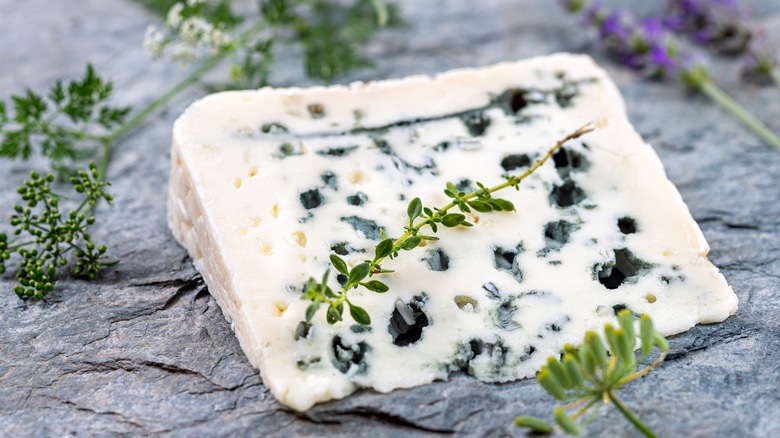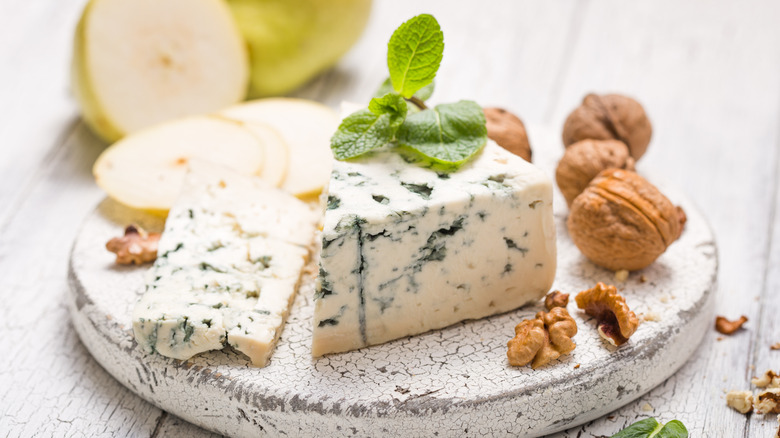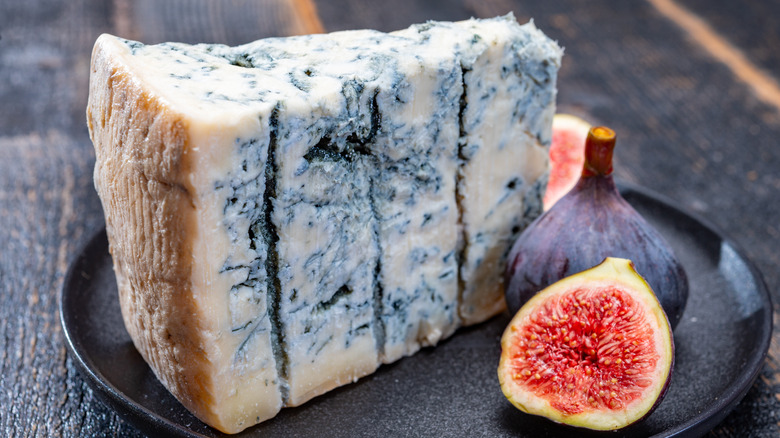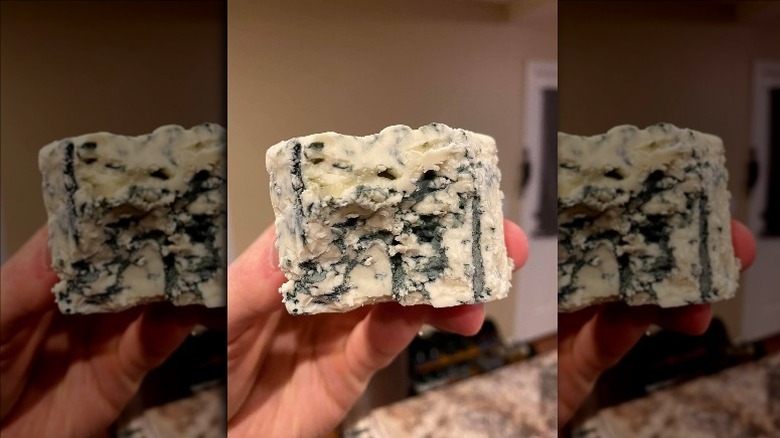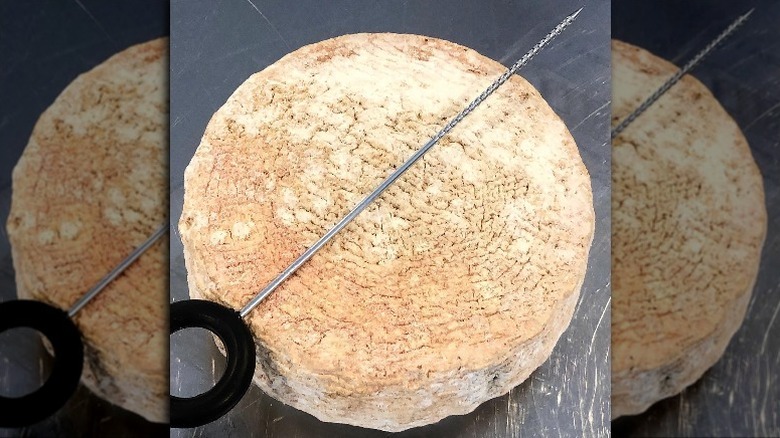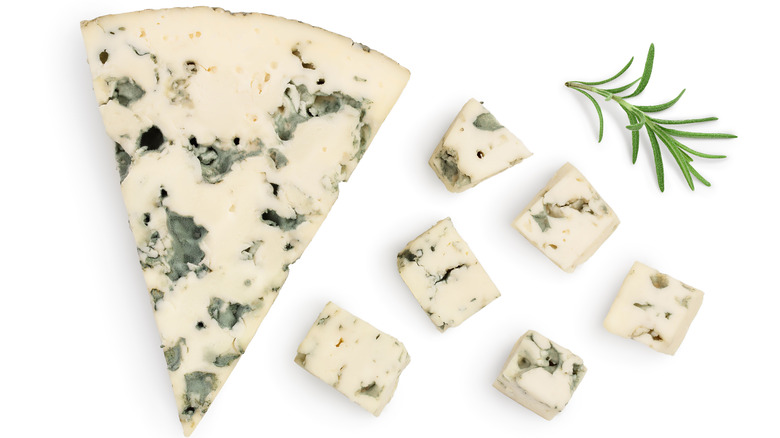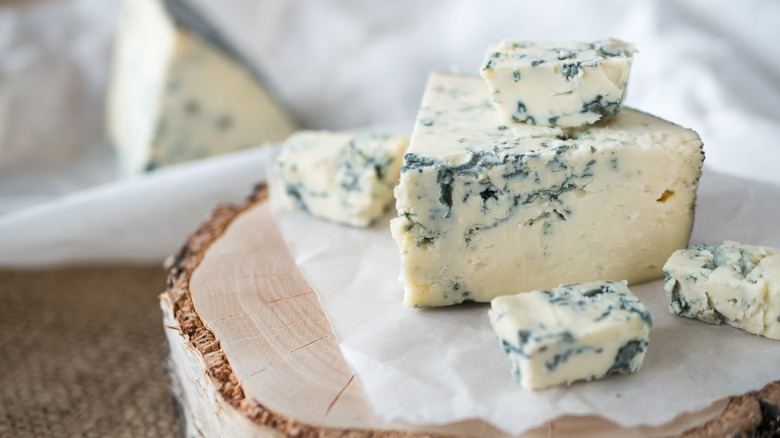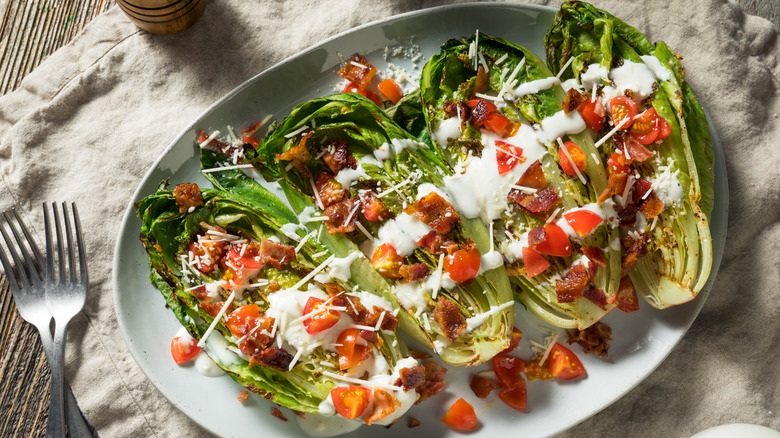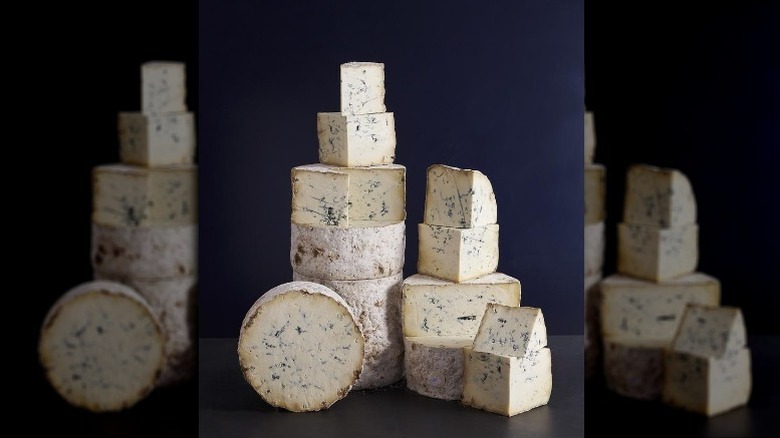The Untold Truth Of Blue Cheese
Blue cheese — also known as bleu cheese — is one of those foods that people either love or hate. That probably has a lot to do with the incredibly strong flavor of most blue cheese. It's salty, it's pungent, and it has plenty of acidity to it. This means it pairs well with a variety of different foods, but it also means that it finds itself ostracized on the charcuterie board by those who prefer lighter, less assaulting cheeses.
However, for those of us who do love blue cheese, nothing's better than digging into some Roquefort or Gorgonzola. But even if you're the type of person who eats blue cheese on the regular, there's probably a lot you don't know about this mysterious food. What's the blue stuff, anyway, and why does it taste so strong? Where did it come from, and how is it even made? These are the questions we're going to dive into.
So, what are you waiting for? Sit back, relax, and learn more about the untold truth of blue cheese.
It's moldy, but it's completely safe to eat
If you opened your fridge and found just about any food that was covered in mold, you would probably throw it away, right? However, as you probably know, blue cheese is riddled with mold — on purpose. In fact, that's exactly what gives it its funky, unusual flavor that you don't get from other cheeses.
Not all mold is created equally, though. So while you probably shouldn't try to serve that moldy baguette at dinner tonight, it's absolutely fine for you to enjoy the mold that's naturally present in blue cheese, which happens to be Penicillium roqueforti and Penicillium glaucum. According to Mashed writer Joel Stice, this mold "accelerate[s] the breakdown of the proteins and fats in the cheese by producing enzymes that release amino acids."
So, not only is the mold in blue cheese safe to eat, but it's actually supposed to be there. While thinking about the fact that you're eating mold might give you pause, it shouldn't bother you too much — this is a safe process, and you shouldn't worry about getting sick from eating blue cheese (unless you're lactose-intolerant, of course!).
There are tons of different types of blue cheese
When you think of blue cheese, perhaps only one type of cheese comes to mind. If you're like many of us, you think of that crumbly, blue-ish white cheese that is sprinkled on top of restaurant salads all the time. While that is, indeed, blue cheese, it's not the only variety out there. In fact, there are a plethora of different types of blue cheese, and it may surprise you just how different they are from one another.
According to Chowhound, the French cheese Roquefort is a blue cheese. This is a well-known type of cheese, but it also tends to be on the stronger side. We wouldn't recommend this stuff unless you're already an avid blue cheese lover. On the other side of the spectrum, you'll find lighter, milder varieties such as Gorgonzola dulce, Mycella Blue, and Cashel Blue.
And what about if you're looking for something that's in the middle of mild and really intense? In that case, you might want to check out your local cheese counter for Gorgonzola, Fourme D'Ambert, and Cambozola. One thing to keep in mind: Don't limit yourself when it comes to blue cheese. Try the different types available to you to see which ones you like best. You may just surprise yourself!
Pink slime is an indication your cheese has gone bad
Just because blue cheese is already covered in mold doesn't mean that it can't go bad. In fact, most of the time, you're going to want to eat up all of your blue cheese within seven days of purchase. That's because mold can grow on blue cheese — and not the good, harmless kind that makes it taste so delicious.
So, how exactly should you know whether the mold on your blue cheese is supposed to be there or not? Well, those blue splotches are totally normal, and you shouldn't be worried about them at all. However, Serious Eats recommends that you should be on the lookout for pink slime on the surface of your cheese. Of course, any change in texture can raise a red flag, but when it's accompanied by a pink hue, you know it's time to throw it out. Additionally, you should make sure the edges of your cheese aren't turning brown either. Keep an eye out for these signs your cheese has gone bad and you shouldn't have a problem.
Cheese makers use needles to add mold to the cheese
So, if mold usually just grows on the surface of foods, you may be wondering how mold actually finds its way into the cheese so that when you cut it, you're left with a beautiful display of blue "veins." You shouldn't be surprised to learn that it does require some serious intervention from cheese makers.
Hy-Vee notes that blue cheese starts off as wheels of non-blue cheese. Then cheese producers must pierce each wheel of cheese several times with long needles. This allows air passages to open up throughout the cheese, and this is where mold is allowed to grow. (The mold is added by the cheese maker as well.) That's where those veins come from: a needle inserted into the cheese to produce pockets of air.
Then, depending on what kind of blue cheese the cheese maker is producing, they will let it age for a set amount of time. After that, it makes its way to your local cheese counter where you pick some up to share with family and friends. We love finding out where our food comes from!
It has an interesting origin story
As it turns out, historians don't really know how blue cheese was originally invented. It's been around for so long, and there aren't reliable records to indicate how it really all began. However, there is one legend that's been floated around for a while. Forbes claims that it was debunked, but it's still a fantastic tale about how people started eating blue cheese.
As the story goes, blue cheese was originally discovered in Roquefort, France. A young man was sitting in a cool cave, enjoying a snack of bread and cheese. But that's when he saw a beautiful woman. He knew that he had to go up and talk to her, so he abandoned his lunch. However, apparently things went well with this woman because he didn't return back to his cave until several months later. When the young man returned, he found that the cheese had turned blue, and thus the very first Roquefort was born.
Now that researchers can trace the genetic history of the mold, they know that this legend probably isn't true. But who doesn't love a story as charming as this one?
Blue cheese is actually really good for you
Sometimes, it can seem like any food that tastes good is actually bad for you. While that assumption may hold true in a wide variety of cases, it falls flat when it comes to blue cheese. Yes, cheese is a dairy product, which means you're not going to want to eat a ton of it if you hope to keep your cholesterol in check. But it turns out that blue cheese offers quite a few health benefits to those who choose to eat it.
According to WebMD, blue cheese has an especially high calcium content. While all cheese packs a decent amount of calcium, blue cheese has even more compared to most other cheeses out there. A single serving can offer about 150 mg of calcium in just one ounce — that's not bad. And because of all that calcium, blue cheese can potentially help lower the risk of osteoporosis.
But the health benefits don't end there. If eaten in moderation, it can also prevent obesity and reduce your risk of heart disease. So, the next time you're stocking up on blue cheese for your fridge, just remember that you're doing something positive for your health.
It pairs well with a wide variety of foods
Of course, blue cheese is absolutely delicious on its own. However, it's not really the kind of food that you tend to snack on all by itself. Rather, you're more likely to see it in a sauce, on top of a salad, or included in a charcuterie board. Therefore, it just makes sense to get a better idea of what you can pair with blue cheese when you want to create a fantastic meal.
Because blue cheese is usually so strong, pungent, and salty, you may want to try to balance those flavors a bit by serving the cheese with something that's on the sweeter side. We think that some fresh fruit like figs could be an excellent addition here. On the other hand, you can also add it to other salty dishes to up the savoriness. For example, you can add blue cheese to a burger for a nice umami touch.
And of course, you can't forget about crumbling it up and putting it in a salad — you certainly can't go wrong there. Or pair it with vegetables by incorporating blue cheese into a dressing or a dip. Just don't be afraid to try out more combos if you really want to taste blue cheese the way it's meant to be enjoyed.
Blue cheeses with softer textures will taste milder
Now, are you ready to go out and pick out some blue cheese of your own? You know what you're looking for, and you're armed with the background knowledge you need. You'll just want to make sure that you choose the right kind. Buying cheese can be difficult if you have a lot of options and you don't know exactly what you're looking for, so it's a good idea to keep a few different factors in mind.
First of all, according to Serious Eats, those who want a milder and less pungent blue cheese are going to want to look for a cheese that has a softer texture to it. The more you work your way into hard and crumbly territory, the stronger the blue cheese is going to taste.
And of course, you shouldn't be afraid to ask your local cheesemonger for help. They can point you in the direction of sweeter or more savory blue cheeses. If you shop at the right spots, you can even find varieties that have complex, peppery notes to them. And feel free to ask for a sample as well!
